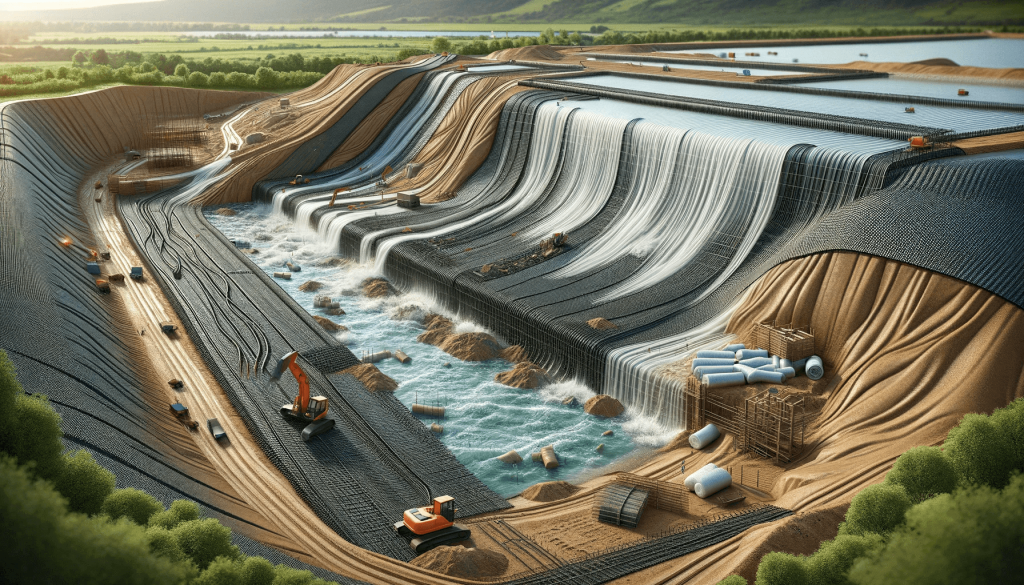
As the world grapples with environmental challenges, the construction industry is increasingly turning towards sustainable alternatives. Geosynthetics, a class of materials with diverse applications in civil engineering and construction, have emerged as promising sustainable substitutes for traditional materials.
In this article, we explore the various ways geosynthetics offer eco-friendly solutions, emphasizing their benefits and applications, particularly in the context of Geosynthetics Malaysia.
Geosynthetics include a variety of synthetic materials designed to enhance the performance of soil and rock in construction projects. These materials typically fall into three main categories: geotextiles, geogrids, and geomembranes.
Geotextiles are permeable fabrics that stabilize soil and prevent erosion, geogrids are reinforcing materials that improve soil strength, and geomembranes act as barriers to control the flow of liquids. These versatile materials serve as a foundation for more sustainable construction practices.
Erosion poses a significant threat to landscapes, especially in regions with heavy rainfall. Traditional methods of erosion control often involve the use of concrete or natural materials, which can be resource-intensive and environmentally damaging.
Geotextiles, on the other hand, offer a sustainable alternative. These permeable fabrics allow water to pass through while preventing soil erosion. In Malaysia, where tropical weather patterns can lead to intense rainfall, geotextiles play an important role in safeguarding construction sites and preventing soil degradation.
In construction, reinforcing soil for load-bearing applications has traditionally relied on materials like gravel or crushed stones. However, these materials can be heavy, require extensive transportation, and contribute to increased carbon emissions.
Geogrids present an eco-friendly solution by providing reinforcement through a network of interconnected polymer or fiberglass grids. The lightweight nature of geogrids reduces the environmental impact associated with transportation, making them a sustainable choice for enhancing soil stability in various construction projects in Malaysia.
As urbanization accelerates, the management of waste and landfills becomes a critical concern. Traditional methods of landfill construction involve clay liners, which are not only labor-intensive but can also pose environmental risks if not properly installed.
Geomembranes offer an efficient and sustainable solution for landfill management. These waterproof synthetic liners act as a barrier, preventing the leaching of harmful substances into the soil and groundwater.
In Malaysia, where waste management is a growing challenge, the adoption of geomembranes can contribute to more sustainable and environmentally friendly landfill practices.
The construction of roads is a vital aspect of infrastructure development, but it often involves resource-intensive processes. Geosynthetics, particularly geotextiles and geogrids, play an important role in sustainable road construction. Geotextiles act as a separator between the road base and subgrade, preventing the mixing of materials and ensuring long-term stability.
Geogrids, on the other hand, reinforce the soil, reducing the need for excessive excavation and the use of traditional, resource-heavy materials. This not only minimizes environmental impact but also contributes to more efficient and cost-effective road construction in Malaysia.
Slope stabilization is an important aspect of construction in hilly or mountainous regions, and traditional methods often involve extensive earthworks and vegetation. Geosynthetic mats provide an innovative and sustainable alternative for slope stabilization. These mats, typically made of synthetic materials, offer erosion control, vegetation support, and reinforcement.
In Malaysia, where uneven terrain is common, geosynthetic mats provide an eco-friendly solution for stabilizing slopes, preventing soil erosion, and supporting the growth of vegetation.
The aquaculture industry faces challenges related to pond construction, water retention, and environmental impact. Geosynthetic liners, especially geomembranes, offer a sustainable solution for pond lining. These liners create waterproof barriers, preventing water leakage and soil contamination.
In Malaysia, where aquaculture is a significant industry, adopting geosynthetic liners can enhance the efficiency and sustainability of pond construction, contributing to responsible water management practices.
While geosynthetics present countless sustainable solutions, challenges remain. Proper installation and maintenance are important to ensuring the longevity and effectiveness of these materials. Additionally, awareness and education within the construction industry in Malaysia are necessary for widespread adoption.
Looking ahead, the future prospects for geosynthetics in Malaysia are promising. As environmental regulations become more strict and sustainability takes center stage, the demand for eco-friendly construction practices will likely drive increased adoption of geosynthetics.
Research and development efforts are also ongoing to further enhance the performance and sustainability of these materials, ensuring a greener and more resilient construction industry in the years to come.
Geosynthetics, with their diverse applications and sustainable benefits, have emerged as valuable alternatives to traditional construction materials. From erosion control to landfill management, road construction to aquaculture, these materials offer eco-friendly solutions for a variety of challenges faced by the construction industry in Malaysia.
As the world continues to prioritize sustainability, geosynthetics are poised to play an important role in shaping a more environmentally conscious and resilient future for construction practices.
Copyright © Gateway Structure Sdn Bhd (199401025111). All Right Reserved.